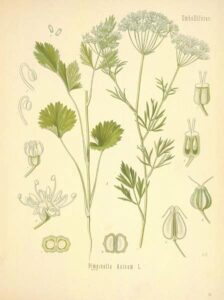Aromatic anise seeds, a revered digestive tonic of the Greeks and Romans, is still used in confectionary and as a flavouring for alcoholic beverages, especially Pernod and Turkish Raki. The essential oil is steam-distilled from the seeds of this perennial herb of the Middle East. It has a rich, pervasive spicy-sweet odour resembling Liquorice.

A potent remedy
Aniseed is potentially therapeutic; warming and enlivening the body, it can be used to invigorate the mind and stimulate the circulation. Its powerful action on the digestive system quells nausea and vomiting and eases indigestion and flatulence. Its expectorant properties are also useful in treating respiratory infections. The potency of aniseed needs to be respected, however. It is recommended for use only when you becomes more proficient in the art of aromatherapy.
Active Ingredients of Aniseed
Aniseed is unusual, being low in aldehydes, alcohols and terpenes, but high in phenols and phenolic esters.
Esters: anethole
Anethole, a phenolic ester, is the principle compound making up 75-90% of the oil.
Phenols
Phenols and phenolic esters are known as bactericides and they contain potent compounds that help to stimulate the immune and nervous systems.
Uses of Aniseed Oil
You should be careful when using aniseed il, but that does not mean you have to avoid it completely. Stick to gentle inhalation techniques to avoid causing damage to sensitive skin.
Star Anise
Star anise, an oil extracted from an evergreen tree native to China, India and Vietnam, shares many properties with aniseed. Their aromas are almost identical and they share chemical components including athenole and methylchavicol. consequently, the oils have similar properties and are often used interchangeably. Star anise is less likely to irritate the skin, but should still be used with caution and avoided altogether during pregnancy.
Food Flavouring

Aniseed is used to flavour cough sweets and aniseed balls as its flavour is sweet and distinctive. In cough sweets, it is famed for its ability to relieve bronchial complaints.
It is also often used as a flavouring in toothpaste, where its antiseptic qualities help flavour the breath and keep teeth clean.
Magic of Aniseed
A revered herb of the ancient Middle Eastern civilisation, aniseed is one of the oldest spices to have been used for magical purposes and healing.
The Ancient Romans believed aniseed to be an aphrodisiac. Cakes flavoured with the spice were served at the end of a marriage feast to relax nervous couples before they retired to bed.
Aniseed is reputed to avert the evil eye. It is also believed to deter venomous snakes such as vipers.
Aniseed was widely cultivated by monks in medieval gardens to be used in the monastery for its purifying properties, precipitating the herb's spread throughout Northern Europe.
Aniseed was so valued in biblical times that it was used to pay taxes and rents.
Asthma and Colds
Aniseed in a vaporiser or steam inhalation eases hayfever, head colds and bronchial complaints such as asthma. It also quells vomiting and nausea. Place a few drops on a handkerchief to ease digestive problems, travel sickness and panic attacks from vertigo.

Emotional balance
Inhaling aniseed enhances relaxation and soothes sleep patterns. It relieves stress from overwork and eases heartache.
Headaches and Migraines
Aniseed helps ease your headaches and migraines - especially in cases where stress is a causative factor.
Tension headaches
Make a vaporiser blend to ease tension headaches by mixing up 5-10 drops from a combination of the following oils:
- Aniseed
- Lavender
- Niaouli
- Peppermint
Place the vaporiser nearby and relax with your eyes closed until the headache begins to ease.